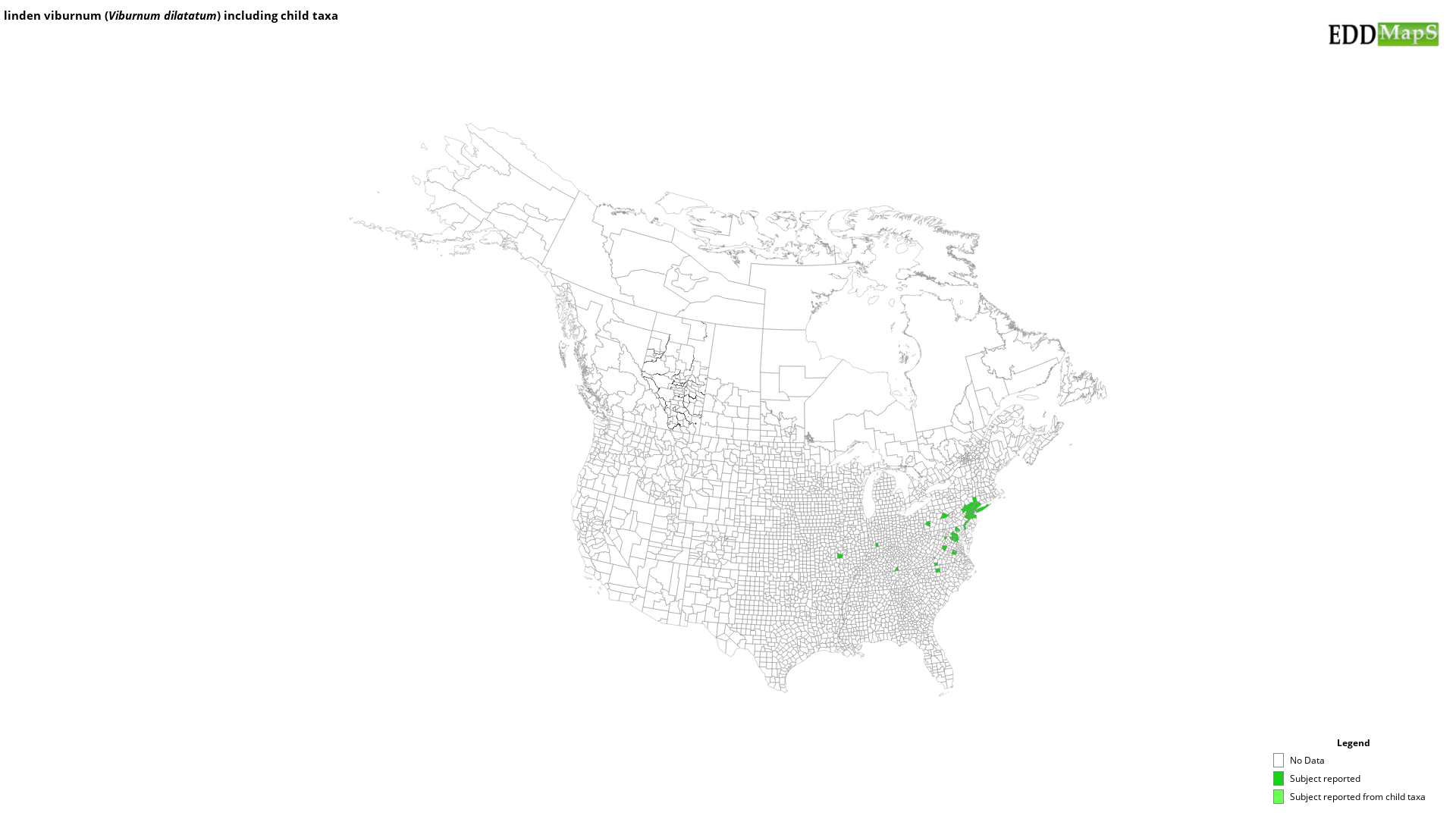linden viburnum
(Viburnum dilatatum)
This species is Introduced in the United States
ORIGIN: China, Japan, Korea
GROWTH TRAITS: Typically grows as a multi-stemmed shrub 8-10' (2.4-3 m) tall. The bark is mostly smooth and gray-brown with distinct orange lenticels. Stems and leaves are often covered in soft hairs. Leaf shape is variable, ranging from nearly round to elliptical to lobed. Leaves are 2-5" (5-12.5 cm) long and are green in summer, turning bronze or burgundy in the fall. Flowers appear in flattened clusters at branch tips. Each flower is 0.25" (6 mm) in diameter. Fruits are slightly oval-shaped, 0.3" (8 mm) long, and green initially but red at maturity.
REPRODUCTION: All three species spread by seed but can also re-sprout from the root system following damage. Seeds of many viburnums remain viable for up to 10 years
.
HABITAT: Species tolerate a wide range of soil conditions and can grow in full sun to partial shade. Grows best in mesic soil in full to partial sun and are typically found at forest edges, fields, and disturbed forests.
LOOK-ALIKES: Several additional viburnum species are native to or have been introduced to North America, and many are difficult to differentiate. They vary slightly in leaf shape, fruit color, buds, and flower and fruit structure.
CITATIONS:
Rawlins, K.A., R.L. Winston, C.T. Bargeron, D.J. Moorhead, and R. Carroll. 2018. New Invaders of the Northeast and Northcentral United States. USDA Forest Service, Forest Health Assessment and Applied Sciences Team, Morgantown, West Virginia. FHTET-2017-04. Retrieved from https://bugwoodcloud.org/resource/pdf/FHTET-2017-04_New%20Invaders_NE.pdf
GROWTH TRAITS: Typically grows as a multi-stemmed shrub 8-10' (2.4-3 m) tall. The bark is mostly smooth and gray-brown with distinct orange lenticels. Stems and leaves are often covered in soft hairs. Leaf shape is variable, ranging from nearly round to elliptical to lobed. Leaves are 2-5" (5-12.5 cm) long and are green in summer, turning bronze or burgundy in the fall. Flowers appear in flattened clusters at branch tips. Each flower is 0.25" (6 mm) in diameter. Fruits are slightly oval-shaped, 0.3" (8 mm) long, and green initially but red at maturity.
REPRODUCTION: All three species spread by seed but can also re-sprout from the root system following damage. Seeds of many viburnums remain viable for up to 10 years
.
HABITAT: Species tolerate a wide range of soil conditions and can grow in full sun to partial shade. Grows best in mesic soil in full to partial sun and are typically found at forest edges, fields, and disturbed forests.
LOOK-ALIKES: Several additional viburnum species are native to or have been introduced to North America, and many are difficult to differentiate. They vary slightly in leaf shape, fruit color, buds, and flower and fruit structure.
CITATIONS:
Rawlins, K.A., R.L. Winston, C.T. Bargeron, D.J. Moorhead, and R. Carroll. 2018. New Invaders of the Northeast and Northcentral United States. USDA Forest Service, Forest Health Assessment and Applied Sciences Team, Morgantown, West Virginia. FHTET-2017-04. Retrieved from https://bugwoodcloud.org/resource/pdf/FHTET-2017-04_New%20Invaders_NE.pdf
Selected Images
Maps
EDDMapS Distribution - This map is incomplete and is based only on current site and county level reports made by experts, herbaria, and literature. For more information, visit www.eddmaps.org
State Lists - This map identifies those states that have this species on their invasive species list or law.
Invasive Listing Sources
- Jil M. Swearingen, Survey of invasive plants occurring on National Park Service lands, 2000-2007
- Jil Swearingen, personal communication, 2009-2017
- Maine Invasive Plants
- Maryland Invasive Species Council - Invasive Species of Concern in Maryland
- National Park Service, Mid-Atlantic Exotic Plant Management Team Invasive Plant List
- National Park Service, National Capital Region Exotic Plant Management Team Invasive Plant List
- New Invaders of the Northeast and Northcentral
- New Jersey Invasive Species Strike Team 2017 Invasive Species List
- Non-Native Invasive Plants of Arlington County, Virginia
- Non-Native Invasive Plants of the City of Alexandria, Virginia
- Nonnative Invasive Species in Southern Forest and Grassland Ecosystems
- Pennsylvania Department of Conservation and Natural Resources Invasive Plants
- Plant Invaders of Mid-Atlantic Natural Areas
- Rhode Island Natural History Survey
- Virginia Invasive Plant Species List
- WeedUS - Database of Plants Invading Natural Areas in the United States
Taxonomic Rank
| Domain: Eukarya |
| Kingdom: Plantae |
| Phylum: Magnoliophyta |
| Class: Magnoliopsida |
| Superorder: Asteranae |
| Order: Dipsacales |
| Family: Adoxaceae |
| Genus: Viburnum |
| Viburnum dilatatum |
References
Common Name Reference: USDA, NRCS. 2010. The PLANTS Database. National Plant Data Center, Baton Rouge, LA, USA.
Scientific Name Reference: USDA, NRCS. 2010. The PLANTS Database. National Plant Data Center, Baton Rouge, LA, USA.


